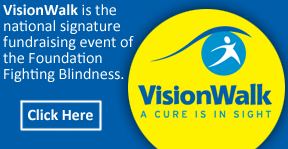What is Usher Syndrome?
What is Usher Syndrome?Usher syndrome is an inherited condition characterized by hearing impairment and progressive vision loss. The vision loss is due to retinitis pigmentosa (RP), a degenerative condition of the retina, and usually appears during adolescence or early adulthood. Balance may also be affected. Symptoms vary from person to person and progress at different rates. Researchers funded by The Foundation Fighting Blindness (FFB) are studying causes and potential treatments for Usher syndrome and other retinal degenerative diseases. Excellent progress in research has been made recently. There are at least three different forms of Usher syndrome. People with Usher syndrome type 1 (USH1) are usually born with severe hearing loss and experience problems with balance. The first signs of RP — night blindness and loss of peripheral vision — usually appear in early adolescence.In Usher syndrome type 2 (USH2), newborns have moderate to severe hearing impairment. Symptoms of RP typically start shortly after adolescence. Visual problems progress less rapidly than in Usher type 1 and hearing loss usually remains stable. A rarer third type of Usher syndrome (USH3) was documented in 1995. Children with USH3 are usually born with good or only mild impairment of hearing. Their hearing and vision loss is progressive, starting around puberty. Balance may also be affected. Hearing loss in Usher syndrome is due to a genetic mutation (alteration) affecting nerve cells in the cochlea, a sound-transmitting structure of the inner ear. The same genetic defect also adversely affects photoreceptor cells in the retina, leading to vision loss. The retina is a delicate tissue in the back of the eye composed of light-sensing photoreceptor cells. These cells — also known as rods and cones — are responsible for converting light into electrical impulses that transfer messages to the brain. How is Usher syndrome inherited?Usher syndrome is passed from parents to their offspring through an autosomal recessive inheritance pattern. In this type of inheritance, two copies of a mutated gene, one from each parent, are required for the child to be affected. A person with only one copy of the gene is a “carrier” and rarely has any symptoms. Genetic counselors are excellent resources for discussing inheritability, family planning, genetic testing, and other related issues. Researchers estimate that as many as 50,000 people in the U.S. have Usher syndrome. Worldwide, it is the leading cause of combined deafness and blindness. Approximately 30 percent of people with RP report some degree of hearing loss, and about half of them are diagnosed with Usher syndrome. Genetic testing is becoming available to help people define their condition and the risk of other family members or future offspring being affected. What treatments are available?Intensive research is under way to discover the causes of, and treatments for, all forms of RP. Researchers have found numerous genetic variations causing Usher syndrome, allowing for the designation of a variety of subtypes (i.e., 1A, 1B, IC, 1D, 1E, 1F, 1G, 2A, 2B, 2C, and 3A). Gene therapy to replace defective Usher genes is being studied in preclinical settings. Researchers have also identified a nutritional therapy to slow the rate of vision loss in some RP patients. Although not a cure, they found that vitamin A palmitate can slow retinal degeneration in some people with RP and Usher syndrome type 2. They also showed that docosahexaenoic acid (DHA) — an omega-3 fatty acid — can enhance the effect of vitamin A. However, the enhanced benefit of DHA was realized only during the first two years of vitamin A therapy. (Only adult RP and USH2 patients were studied, so the effect in other patients with Ushers Syndrome is not known.) FFB can provide you with the recommendations of the study’s author. A Phase II/lll human clinical trial is underway to test encapsulated cell technology (ECT) for delivery of a vision-preserving, therapeutic agent (ciliary neurotrophic factor or CNTF) to the retina. Preliminary results from the phase I study of the ECT-CNTF treatment were highly encouraging. Other therapeutic agents are showing promise in pre-clinical studies. In addition, numerous researchers are experimenting with artificial retinal implants. The devices are placed on the surface of the retina and restore rudimentary, functional vision. Researchers are also making excellent progress in gene therapy to treat Usher syndrome. With gene therapy, a normal gene is delivered to the retina to replace the mutated, disease-causing gene. The gene therapy may also be used to treat hearing loss. In clinical trials of a gene therapy for a severe form of RP known as Leber congenital amaurosis, some vision was restored in young adults who were nearly blind. Success with this treatment opens the door for the development of gene therapies for Usher syndrome and other retinal diseases. Retinal cell transplantation is another area of growing interest. In these potential treatments, transplanted retinal cells would replace retinal cells lost to RP and other retinal degenerative diseases. Are there any related diseases?Other conditions, some of which are also inherited, can result in deafness and deaf-blindness, but are not related to Usher syndrome. However, the RP associated with Usher syndrome shares most of its characteristics with other forms of RP. Researchers expect that advances in understanding and treating other forms of RP will directly benefit people with Usher syndrome, and vice versa. |

Chapters
Select a state from the dropdown below to view local chapters.
Free Information
Register here to receive free information about your eye condition and research efforts to find treatments and cures.
- 05/09/09 - Alexandria - Northern Virginia/DC Metro VisionWalk
- 05/09/09 - New York - New York City VisionWalk
- 05/09/09 - Cleveland - Cleveland VisionWalk
- 05/09/09 - Fort Wayne - Fort Wayne: Dinner with Tom Sullivan
- 05/12/09 - Beverly Hills - Los Angeles Dining in the Dark









